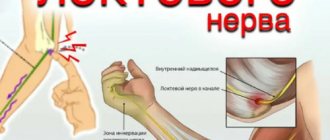Myotonic syndrome is a complex of neuromuscular disorders in which a person's ability to relax after contraction is impaired. Myotonic syndrome is characterized by a predominantly hereditary nature - it is a genomic pathology of an autosomal recessive or autosomal dominant type of inheritance. The characteristic symptoms of myotonia are: muscle hypotonia and weakness, subsequently spasms, pain and tension.
Diagnosis and treatment of myotonic syndrome is carried out at the rehabilitation center of the Yusupov Hospital - the leading medical center in Moscow, equipped with the latest medical equipment, allowing our highly qualified specialists to accurately and quickly detect the pathology and select the most effective individual treatment regimen.
Classification of myotonia
According to the common classification, the following types of myotonia are distinguished:
- congenital myotonia, known as Thompson's disease;
- cold paramyotonia (Eilenburg disease);
- atrophic myotonia (Rossolimo-Batten-Steinert-Kurshman disease; dystrophic myotonia);
- paradoxical myotonia;
- Schwartz-Jampel syndrome.
In addition, there is a classification based on the etiological factors that trigger the development of the myotonic phenomenon. Based on this classification, the following are distinguished:
- percussion myotonia;
- action myotonia;
- electromyographic myotonia.
Patients with percussion syndrome experience muscle contractions when struck vigorously with a hammer. With myotonia of action, the patient feels difficulty when trying to quickly clench and unclench a fist. In the case of electromyographic myotonia, when performing an electromyogram, discharges are detected, the frequency of which first increases and then decreases. In this situation, the phenomenon of myotonia is caused by worsening membrane instability in the muscle fiber structure.
Myotonic syndrome
Indicators of an attack are difficulties that arise when trying to stand up, as well as a feeling of tension. Increased tone entails slow relaxation. Myotonic syndrome in a broad sense is any impaired relaxation of increased muscle tone, which does not relate to either pyramidal or extrapyramidal hypertonicity.
The duration of a myotonic attack ranges from several tens of seconds to several tens of minutes. The intensity of the attacks varies from mild stiffness to partial blocking of motor function. The cause of attacks can be both strong physical exertion and a long stay in a state of relaxation. Cold or loud noises can also trigger a reaction. The disease affects only skeletal muscles. Accordingly, an attack is only the result of conscious movements, i.e. muscle fibers involved in organ function are not associated with this disease. Myotonia manifests itself in contractions of the muscles of the legs, face, arms, and shoulder girdle. In rare cases, this disease can also affect the ability to speak.
Any person can get myotonic syndrome because it is caused by genetic determination. The first attacks can appear at any time, regardless of age. The first symptoms of the disease, according to research, appear already in early youth, but the disease can also have a delayed effect and appear, for example, already in a more mature period. Inheritance occurs along an autosomal dominant or autosomal recessive path.
Autosomal dominant inheritance
A defect transmitted in this way always affects all new generations. In the “autosomal” type, the defective gene can be found in any cell except the sex cells. In this version, one carrier is quite enough, and it does not matter whether it is the mother or the father. In this case, every child from any carrier parent can be born with a genetic error with a 50% probability. The age of manifestation and development of the disease are individual in this case.
Autosomal recessive inheritance
Recessive inheritance involves the manifestation of a genetic defect in one generation without the obligatory “familiality” of the disorder. For a genetic defect to occur, two parents must have the defective gene. However, their disease may never manifest itself. In 25% of cases, there is a chance of inheriting a genetic error from two parents. In cases where only one parent is a carrier, the disorder may also be inherited by the child. And he, in turn, will also become a carrier of the defective gene, but the signs will probably not appear. In this situation, there is a 50% chance that the newborn will inherit the defect. However, there is a 25% chance that inheritance will not occur.
Types of myotonia. Myotonia congenita
This type of disease is one of the most common regressive forms of the syndrome. The cause of the disease is associated with a mutation in the gene that controls sodium ion channels in muscle fibers. The disease does not affect life expectancy, and also practically does not change the appearance or shape of the skeleton. This type of myotonia is divided into two subtypes according to the types of heredity.
Severe generalized Becker myotonia, transmitted by an autosomal recessive type, is more common than other types and is a rather severe form of the disease. This type is named after the German geneticist Peter Emil Becker, who first described the disease. The disease develops from 4 to 12 years in girls and about 18 years in boys. The intensity of symptoms may increase aggressively for several years after the diagnosis is confirmed, or more slowly until the patient reaches the age of 20 years.
Thomsen's hereditary disease, transmitted in an autosomal dominant manner, is accompanied by prolonged tonic muscle spasms. The disease is named after the Danish doctor Asmus Julius Thomsen. The doctor himself discovered this disease in himself and his family and began to study its course on himself. As a rule, the disease first makes itself felt at the age of 6-10 years and is expressed in prolonged, non-painful muscle contractions lasting up to several tens of seconds. The symptoms of this disease are usually not as severe as with Becker's disease. There are, however, cases where symptoms hardly appear for several years after the disease is discovered.
To diagnose, you can use a very simple test - going up and down stairs. Difficulties while moving on a flat surface may arise if the patient was previously at rest for a long time, as well as due to a change in the pace of movement. Spasms in the arm muscles can cause problems when writing or shaking hands. There may also be difficulties in pronouncing the first few words, in the process of swallowing, during the first chewing movements, etc. Spasms can also occur in the orbicularis oculi muscles.
Both Thomsen's disease and Becker's disease are characterized by generalized myotonia caused by voluntary contractions. This is mainly due to increased physical activity or, conversely, to a prolonged lack of movement and relaxation in the muscles. The disease is especially pronounced in the legs, which manifests itself in difficulties while walking, and sometimes can cause falls. The disease is also expressed in stiffness of the shoulder muscle girdle and head muscles. Patients may have problems chewing, blinking, or grasping objects. Also, the consequences of attacks can be immobilizing weakness.
After attacks in both cases of myotonia, the easiest way to reduce tension in the affected areas is by repeating the movements. Seizures manifest themselves in intense muscle contractions. After an attack, you need to activate the contracted muscles several times and after five repetitions the level of tension will begin to subside. This is called the warm-up effect, which allows patients to participate in certain strength sports.
In both cases, patients have non-standard sizes of the muscle girdle, especially on the legs, buttocks, arms, shoulders and back. Sometimes patients with these diseases look like real bodybuilders, however, in fact, this is the result of muscle hypertrophy. The latter is especially noticeable in Becker's myotonia.
Paramyotonia congenita
This is a rare constitutional disorder characterized by prolonged muscle contractions. The disease is caused by disturbances in sodium channels and is transmitted in an autosomal dominant manner. The intensity of the disease persists throughout life. The disease manifests itself in the early stages of life. Tonic muscle contractions cover the arms, face, and neck. The impetus that causes the disease can be an increased degree of stress, as well as cold. In the latter option, the attack can be calmed by warming the area affected by the attack.
As a rule, during attacks of muscle contractions, there is immobilization and increased weakness of the corresponding areas. In this case, weakness can last even after the attack, up to several hours.
However, with paramyotonia congenitis there is no weakness. Also, paramyotonia is characterized by an increase in muscle tension that occurs after an attack, this significantly reduces the ability to move. In medical practice, this phenomenon is called paradoxical myotonia.
Schwartz-Jempel syndrome
This type is also called myotonic chondrodystrophy. It is quite rare and is inherited in an autosomal recessive manner. The first symptoms are usually noticeable already in the first year of life, accompanied by increasing and intensifying muscle tone. Spasms are caused by spontaneous high-frequency discharges of muscle fibers and peripheral nerves. With this disease, muscle spasms occur mainly in the face and thighs. There is also a speech disorder with changes in facial configuration. People with Schwarz-Jempel syndrome suffer from a variety of skeletal abnormalities, which typically cause growth problems. In addition, the disease is externally manifested by low-set ears, a high palate, blepharophimosis, a mask-like face with a large number of wrinkles in the mouth, and a chin that is slanted from tension. There are cases when patients experience a decrease in brain activity.
The cause of Schwartz-Jempel syndrome is unknown. Presumably, this is one of the types of muscle activity disorders. The syndrome is also explained by a possible combination of disorders of neuromuscular excitability.
Diagnostics
In principle, a doctor can make a diagnosis of myotonia during a physical examination using various tests, including stimulation such as squeezing and unclenching a ball. However, it is critical to determine whether it is a progressive disease such as myotonia atrophica or Schwartz-Jempel syndrome, or whether it is a myotonic syndrome. In this case, it is necessary to undergo laboratory tests, for example, electromyography. EMG is used to record the electrical activity of skeletal muscles. Blood tests, genetic analysis, and muscle biopsy are also needed.
Treatment
Today, it is not possible to get rid of any of the listed myotonic syndromes one hundred percent.
The intensity and methods of treatment depend on the symptoms. With increased intensity and frequency of attacks, special medications are prescribed to block the symptoms. Among the prescribed drugs are such drugs as mexilitene, guanine, procainamide, tegretol, phenytoin. A significant disadvantage of these drugs is the presence of a large number of side effects, and it is not recommended to abuse them. A more effective way is to identify what exactly can trigger the symptoms and avoid these moments. If, however, a myotonic attack could not be avoided, then it is better to help muscle recovery with quiet rest. Author: K.M.N., Academician of the Russian Academy of Medical Sciences M.A. Bobyr
Etiology and pathogenesis of myotonia
The main etiological factor provoking the development of myotonia is autosomal dominant or autosomal recessive hereditary transmission. Often this disease occurs as a result of consanguineous marriage.
Muscle dysfunction in myotonia is provoked by a disorder of cell membrane permeability, changes in mediator and ion metabolism.
The pathogenesis of atrophic myotonia is represented by a dysregulation of the hypothalamic-pituitary system. During a pathomorphological examination, changes in muscle tissue are diagnosed. Histological examination allows us to specify the decrease in size and increase in the number of type I fibers.
How to detect in adults?
In order to identify myotonic pain syndrome, specialists at the Yusupov Hospital use a multidisciplinary approach involving neurologists, orthopedists, therapists, and ophthalmologists.
First of all, the doctor collects the patient’s hereditary history: finds out information about the presence of myotonic syndrome in members of the patient’s family. Then, using a percussion hammer, he taps the muscles to identify the defect.
In order to identify the myotonic reaction to external stimuli (stress, sharp sounds, cold), specialists at the Yusupov Hospital conduct a specific test.
Electromyography allows one to study the bioelectric potentials that arise in skeletal muscles when muscle fibers are excited.
A blood test is performed to determine paraclinical and biochemical parameters.
Additionally, molecular genetic testing, biopsy and histological examination of muscle fibers are prescribed.
Clinical picture of myotonia
The clinical manifestations of this disease depend on its form. With congenital myotonia, in most cases, the first symptoms appear in childhood (10-12 years). A child with congenital myotonia develops a change in voice that is noticeable when crying. The child is subjected to an attack of suffocation, and after he calms down and stops crying, the facial muscles gradually relax. At older ages, patients develop a typical myotonic phenomenon. Patients often complain of local muscle hypertonicity, which is accompanied by normal muscle contraction and difficult muscle relaxation. This is caused by a spasm or characteristic muscle contracture. These difficulties are in most cases localized in the masticatory muscles, hands and fingers, and in severe cases, all muscle groups can be affected.
During the examination of the patient, signs of mechanical hyperexcitability of the muscles are visualized. After a blow with a hammer, a deformation in the form of a pit or ridge may be present on the affected muscle for 1-1.5 minutes. In the process of gradation of the disease, patients with congenital myotonia develop muscle hypertrophy, against the background of which an athletic physique is formed. At the same time, the patient’s appearance does not correspond to muscle strength; as a rule, it is significantly lower.
Intensification of symptoms occurs under the influence of cold or excessive physical exertion. In women, the clinical picture may worsen during pregnancy.
Thompson's myotonia in most cases is characterized by a mild course, and in some patients the symptoms weaken with age.
The first symptoms of atrophic myotonia occur in patients aged 15-35 years. The onset of the disease is accompanied by myotonic syndrome, which subsides over time as atrophy and paresis develop. After the myotonic syndrome subsides, patients experience a gradation of myopathic symptoms. Along with muscle atrophy, there is a decrease in muscle strength. Initially, this type of myotonia is characterized by atrophy of the muscles of the face, neck, and masticatory muscles; over time, the muscle structures of the upper and lower extremities are involved in the pathological process.
With atrophy of the masticatory muscles, retraction of the cheeks and temporal fossae is visualized. The spread of the process of muscle atrophy in the neck area is indicated by throwing the head back or forward. During the examination, pathological changes in the muscles of the upper and lower extremities and decreased tendon reflexes are noted.
The endocrine system suffers, which manifests itself in dysfunctional disorders of the gonads, thyroid gland, adrenal glands and pituitary gland. Patients experience loss of teeth, hair, weight loss and thinning of the skin. From the cardiovascular system, there is a high risk of developing bradycardia, arrhythmia, meter valve prolapse, and hypotension. In some cases, the central nervous system is affected, which manifests itself in mental disorders of varying degrees.
The development of Eidenburg's congenital paramyotonia most often occurs as a result of cold exposure. In this case, the patient feels myotonic difficulty in muscle relaxation. Hypothermia can be local or general. In the case of local hypothermia, when the patient eats food that is too cold, a muscle spasm occurs, which manifests itself in the form of myotonic contracture in the tongue and pharynx, which is eliminated by warming. If hypothermia is of a general nature, a typical myotonic phenomenon develops, and some patients experience muscle weakness, “cold paralysis.” This form of myotonia may regress over time.
Scientists have not established a clear hereditary predisposition in patients with paradoxical myotonia. This disease is extremely rare and its characteristic symptom is a typical myotonic spasm, but which, unlike other myotonic spasms, does not weaken with repeated movements, but rather increases.
The first manifestations of Schwartz-Jampel syndrome occur in early childhood. Visually, this disease is evidenced by the child’s short neck, chest deformation, scoliosis, the child lags behind his peers in growth, but his intelligence remains normal. An objective examination reveals painful muscle contractions of various locations.
Types of myotonia
Myotonia congenita
Myotonia congenitis is the most common non-progressive form of myotonic syndrome and is caused by a mutation in the gene responsible for muscle sodium ion channels. This form of myotonia has no effect on life expectancy and has little effect on body structure or musculoskeletal growth. There are two forms of myotonia congenitis depending on the type of inheritance.
A common and rather severe type of myotonia congenitis is generalized Baker's myotonia, and the inheritance of this disease occurs in an autosomal recessive manner. The debut of this form of myotonia occurs in childhood or early adolescence, but sometimes with a severe course the debut can occur in early childhood. Symptoms may increase progressively over several years after diagnosis or gradually increase until the patient reaches twenty years of age.
The autosomal dominant form of inheritance is called Thomsen's disease. The disease is named after the Danish physician Asmus Julius Thomsen, who had the disease and traced the disease to his family. Symptoms of Thomsen's myotonia are usually much milder than with Baker's myotonia, although the onset of the disease occurs earlier, and the first signs become noticeable in early childhood and sometimes at birth. In rare cases, symptoms may be mild for many years after diagnosis.
The main symptom of both diseases is generalized myotonia caused by voluntary movements. As a rule, such symptoms are provoked by significant physical activity or, conversely, by a long period of rest and muscle relaxation. Myotonia is more severe in the legs, causing difficulty walking and sometimes even falling. Myotonia also affects the muscles of the shoulder girdle and head, which can cause difficulty grasping objects, chewing, or blinking. In rare cases, Baker's myotonia may have immobilizing weakness that appears after the myotonic attack.
After a myotonic attack, in both types of myotonia, stiffness can be relieved by repeated movements in the stiff muscles. Typically, stiffness increases after the first few contractions of the muscles involved, and then after five contractions, myotonic stiffness disappears, allowing normal muscle function to be restored for a certain period of time. This effect is called the warm-up effect and allows people with myotonia to engage in strenuous physical activity and strength sports.
And although myotonia congenitis does not significantly affect the formation of the musculoskeletal system, at the same time, myotonia affects the size of certain muscles. Both Baker's and Thomsen's myotonias can cause an unusual increase in the size of skeletal muscles, especially in the leg region of the buttocks, but also in the region of the arms, shoulders and back muscles. This increase can be considered muscle hypertrophy and sometimes such patients look like real athletes. With Baker's myotonia, muscle hypertrophy is more pronounced than with Thomsen's myotonia.
Paramyotonia congenita
This myotonia is a rare pathology associated with a disorder of sodium channels and is transmitted in an autosomal dominant manner. This type of myotonia does not shorten life expectancy, and the intensity of myotonia remains stable throughout life. The onset of the disease occurs between birth and early childhood. The characteristic symptom of paramyotonia congenitis is generalized myotonic stiffness, which mostly affects the hands and face, as well as the neck and arm areas. Just as with other non-progressive myotonias, paramyotonia congenitis is provoked by intense voluntary exercise, and in some cases provoked by low temperature. In many cases, cold-induced myotonic attacks and associated muscle stiffness can be relieved by heat.
Myotonic stiffness attacks are often accompanied by immobilizing weakness in the affected areas. The weakness may be longer lasting than an episode of myotonic stiffness, weakening the muscles for a period of minutes to several hours. But weakness is not characteristic of paramyotonia congenitis. In addition, unlike other non-progressive forms of myotonia, paramyotonia does not have a warm-up effect, in which stiffness decreases after several muscle contractions. Conversely, myotonic stiffness usually increases after continued muscle activity, further reducing motor performance. This phenomenon is usually called paradoxical myotonia.
Schwartz Jampel syndrome
Schwartz-Jempel syndrome is the most severe form of non-progressive myotonia. This very rare type of myotonia is transmitted in an autosomal recessive manner. The onset of the disease occurs either immediately after birth or a short time after birth. The nature and intensity of symptoms may have individual characteristics. One of the main symptoms is myotonic stiffness, most pronounced in the face and hips. With this myotonia there is a tendency to falls, speech disorders and facial changes. As with myotonia congenitis, additional muscle contractions cause a warm-up effect and reduce stiffness. But the warm-up effect is insignificant, and in some cases absent. Schwartz-Jempel syndrome is characterized by various skeletal deformities. These deformations cause a growth problem in the body and, as a rule, this is manifested by a decrease in height, as well as facial abnormalities, which gives the face a mask-like shape. Other symptoms include hypertrophied hips, atrophied shoulder girdles and prolonged muscle twitching, and sometimes intellectual impairment.
The cause of Schwartz-Jempel syndrome is not known. It is possible that this type of myotonia is a type of muscle disorder, and it is also possible to have a connection with disorders in the nervous system or is a combination of disorders in the muscles and nerves.
Differential diagnosis
The essence of the differential diagnosis of myotonia is to determine the form of this disease. To distinguish the congenital form of myotonia from the dystrophic one, an analysis of clinical manifestations will be required. But sometimes with congenital myotonia, mild weakness of the distal muscles of the upper limbs and weak activity on EMG are detected, which is represented by a symptom of dystrophic myotonia. Continuous muscle activity may indicate neuromyotonia; this symptom is also included in the symptom complex of a rigid person. A distinctive feature of rigid person syndrome is a decrease in muscle activity during sleep and after the administration of diazepam.
Pathogenesis
Since myotonia combines a whole heterogeneous group of neuromuscular diseases, their pathogenesis is different. For example, in congenital myotonia, disorders develop as a result of channelopathies, and dystrophic myotonic failures are associated with the expansion of trinucleotide repeats. In addition, the pathogenesis may be based on mechanisms such as:
- changes in the permeability of ion channels (the entry of chlorine into the myocyte) as a result of mutations, an accumulation of potassium in the cells occurs and a disturbance in the rate of repolarization and depolarization of the myocyte membranes, which increases the excitability of the sarcolemma, which is clinically manifested by an increase in muscle tone;
- disorder of adaptive-tonic muscle function;
- instability of muscle fiber membranes and the occurrence of repeated discharges of muscle contractions after a single stimulus or a short period of contraction (tension).
Classification
Myotonias are usually divided into hereditary ones, which can be stationary, slowly progressive, periodic and recurrent, and also include myotonic syndrome.
Myotonias are dominant inherited (Thomsen), recessive inherited (Becker), Isaacs neuromyotonia, pseudomyotonia and congenital paramyotonia.
Paramyotonia is characterized by paradoxical myotonic actions and variations in the severity of the condition - from permanent generalized attacks to complete regression of symptoms with age.
Tests and diagnostics
In addition to obvious signs of the clinical picture, data from studies such as global electromyography (presence of a myotonic response, variations in oscillations of 20-80 cycles/sec) and molecular genetic analysis are taken into account.
Thanks to light microscopy, various pathomorphological disorders can be detected:
- with Thomsen's myotonia, individual muscle fibers are hypertrophied, and a decrease in the size of muscle fibers occurs according to type II;
- with dystrophic myotonia Rossolimo-Steinert-Kurshman, atrophied and hypertrophied bundles of muscle fibers are combined together, connective tissue grows, muscle tissue is replaced by fatty and connective tissue.








